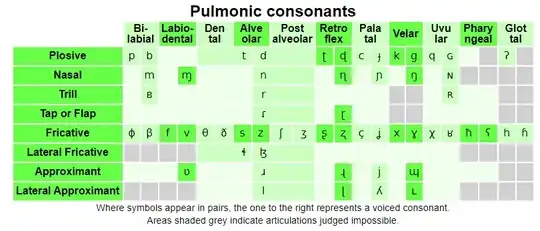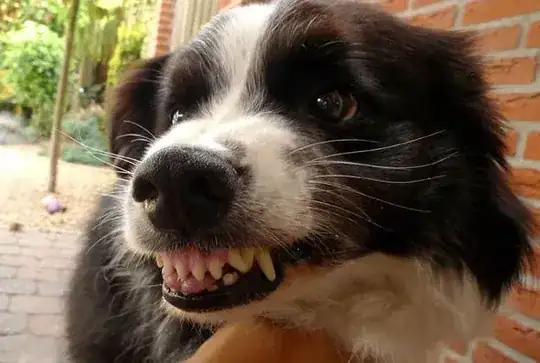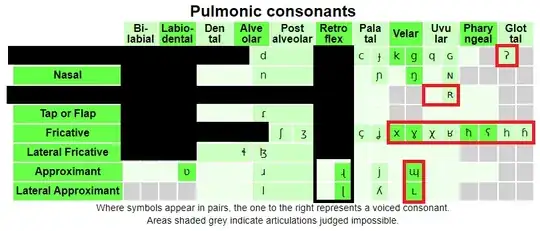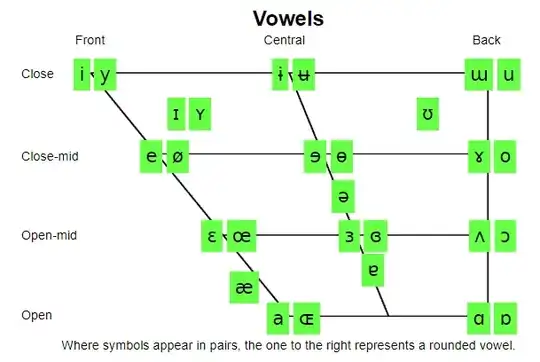Let's start by looking at the possible human sounds in the IPA's pulmonic consonants, it's points and manner of articulation, and figure out what in this human-based inventory a wolf may be able to produce consistently. 
Right off the bat we should note that animals like wolves have relatively little control over their front lips (only really moving the front of their mouth for a submissive grin) making the articulation of the lips for the bi-labial and labio-dental columns infeasible in my opinion.

Dental sounds, remembered from a human form, may be possible since they do not require difficult lip movements.
I can't see any reason why alveolar/post alveolar sounds would be infeasible for a long-muzzled creature, but the tip of a canid's tongue has less strength and articulation than a human's, so that will potentially be an issue that could prevent these phonemes from being reliably produced.
Same with Palatal, Velar, etc. Actually those consonants with further back point of articulation would probably be the most natural for a dog or wolf to make; think growls, murrs and other far-back fricatives that dogs are fond of.
Retroflex may be tough, as it'd require the creature to stretch their mouth open wider to accommodate the curve of such a long tongue.
I'm very dubious about how a creature with a long tongue would produce trills, especially since dogs have thinner tongues with less articulation at the tip.
Plosives all seem out of the comfort zone of most dogs, so keep that in mind.
Approximants are your friends because they do not require total closure/contact in order to be produced, and therefore will be easier to make in general.
Lateral Approximants and Fricatives are also good, as a lateral movement of a dog/wolf's lips is completely natural to them.
It'd be good, when considering canine conlangs, to watch videos of 'talking dogs' and listen to what phonemes the dog produces most naturally. Dogs tend to have a preference, to my ear, for: velar, uvular, pharyngeal and glottal fricatives; what sounds like a lot of uvular trills; aspiration; length, tone and stress distinction on vowels.
Dogs also don't have a uvula so they wouldn't be able to produce uvular sounds.
Look into those light green and gray squares in the image; those are points + manners of articulation deemed rare or impossible for a human.
The whine a dog makes isn't anywhere on here of course, but it'd be a natural sound for the wolf form, and replicable for the human form.
(What any whine would be called on this chart is a question that I'm not sure I'm equipped to tackle.)
I made a rough chart of consonants to seek or avoid: those best left alone are blacked out, and the most important ones boxed in red. The most of a dog/wolf's articulation is in the back of the mouth, so that's where the phonemes are.
Retroflex approximants are often made when dogs yawn, so I left them in this modified chart. That said they are unlikely to be any more phonemic than the clicks an English speaker makes when tsking at someone.
The problem with labial consonants is not having the articulation to make a perfect mouth seal, so a labial approximant is perfectly fine.

And what about vowels? Vowels are easy as pie for a dog to make, and it's a good place to put tone, length, nasalization, aspiration, rhotacizing, vocal fry and stress for variation, so you don't need to have many vowels at all to be able to thicken your phonemic inventory.

I wouldn't discount wolves or dogs as incapable of rounded vowels, as they can round their lips just fine to howl. I've heard many a dog pronounce a phoneme equivalent to /ɔ/, though in vowels especially I think you can hear the difference in a dog/wolf's skull and mouth shape.
That said the IPA vowel chart still applies with it's handy mapping of place/manner of articulation.
A dog can pronounce a rounded back vowel with an open mouth, and even if it has different auditory qualities than a human /ɒ/ it's still a /ɒ/ to me.
However I'm sure a shifter would be able to mimic human vowels just fine with practice, but it wouldn't be natural for every shifter to force their mouths to work like that. These vowels are analogous enough that it seems likely that shifters would just have a 'human dialect' and a 'wolf dialect' that are mutually intelligible.
Front vowels could be tricky though, especially the front closed set /i/ and /y/ which Ive never heard a dog make. It's hard for me to make conclusive statements on this however, as most vowel sounds I hear out a dogs mouth have significant vocal fry or heightened pitch, making them very different to my ears.
Do what feels right, listen to the sounds dogs make (they're much closer to wolves than most people think)



